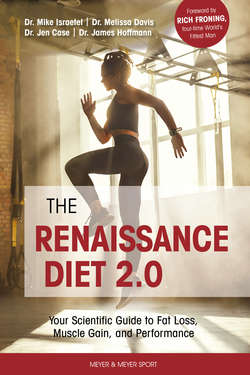Читать книгу The Renaissance Diet 2.0 - Mike Israetel, James Hoffmann - Страница 41
На сайте Литреса книга снята с продажи.
PROTEIN
ОглавлениеProtein is made of large molecules which are made of other, smaller molecules called amino acids. Protein makes up many of the tissues in the human body and comprises enzymes that govern reactions and underlie most bodily functions at some level. Human proteins are comprised of 20 amino acids, of which our bodies can produce 11 endogenously. The other nine amino acids must be ingested via food sources.
There is a balance between protein degradation and protein synthesis in the body, termed “protein turnover.” Some of the amino acids that are liberated when protein is degraded are lost in urine, sweat, and other bodily fluids. Cells full of protein are lost constantly in skin, hair, and intestinal lining. Other amino acids are burned for energy, especially when carbohydrates and fats are not available in sufficient quantities to meet immediate energy demand. In order to address this net loss, amino acids must be consumed regularly via protein consumption.
Protein is critical to survival and health, but it also plays an important role in performance and body composition. Muscle mass is predominantly constructed from protein. Actin, myosin, titin, nebulin, and many other protein compose the contractile apparatus. Protein from the diet supports replenishment of skeletal muscle as it is broken down to support important bodily functions–this helps keep your muscles from shrinking over time. Thus, protein consumption is anti-catabolic as it helps maintain muscle tissue equilibrium. When muscle growth is the goal, there must be a positive net balance of amino acids. Building new tissue is termed “anabolism.” Constructing new muscle with an amino acid surplus is an example of an anabolic process.
In terms of performance, enzymes (made of protein), mediate all energy-liberating and movement-producing activity in the human body. Protein also makes up a huge percentage of connective tissues such as tendons, ligaments, and bones. Undereating protein not only shrinks the muscles that drive performance, but it can also reduce the amount of hemoglobin (the unit that helps blood carry oxygen to the muscles) that supports endurance, weaken joints and bones, and degrade functions supporting health–the base upon which performance is built.
Figure 3.2 Protein has the largest impact on body composition and performance of the macronutrients and thus must be a priority in a structured diet.
Because amino acids literally are the building blocks of most of our body’s functional and structural machinery and because new amino acids are mostly sourced from diet, protein is the most important macronutrient for body composition and health. Research on performance and body composition shows that although variations in fat and carb intake significantly impact outcomes, variation in protein availability also does so to a much greater extent.
